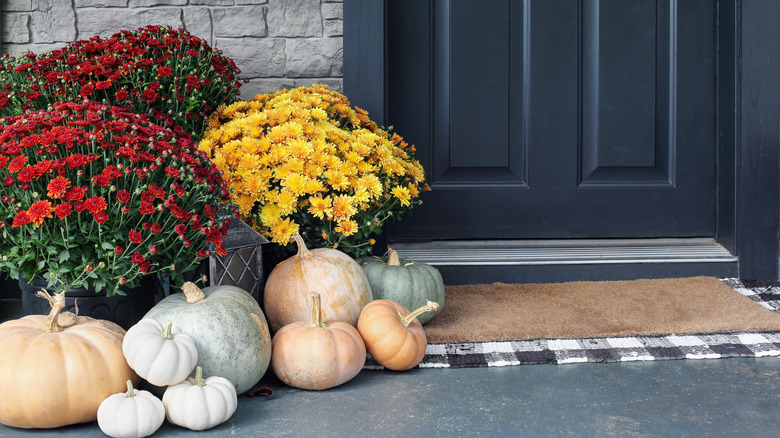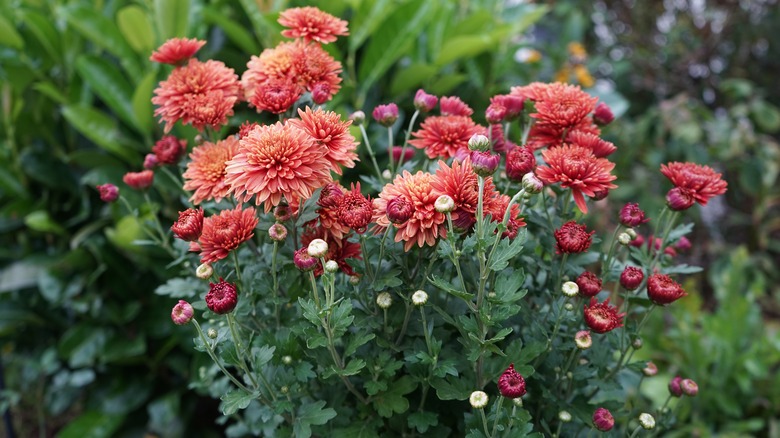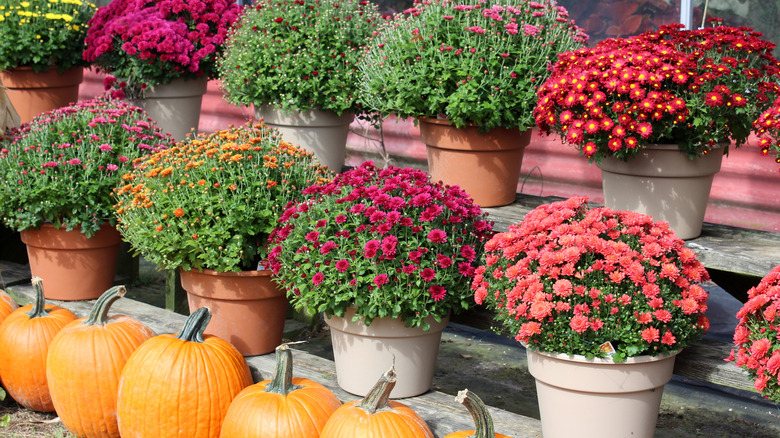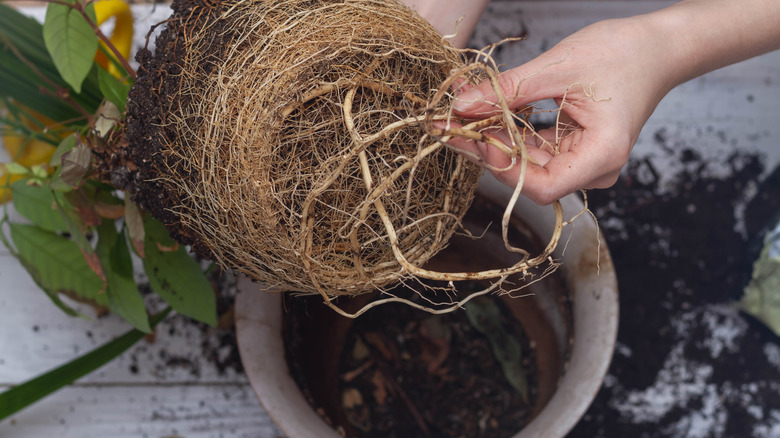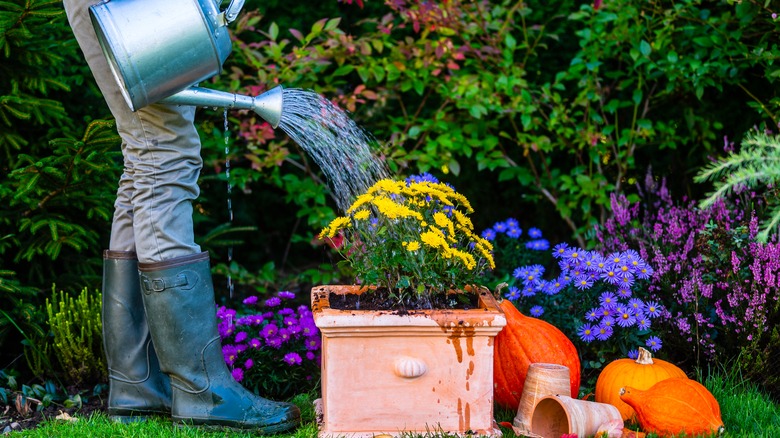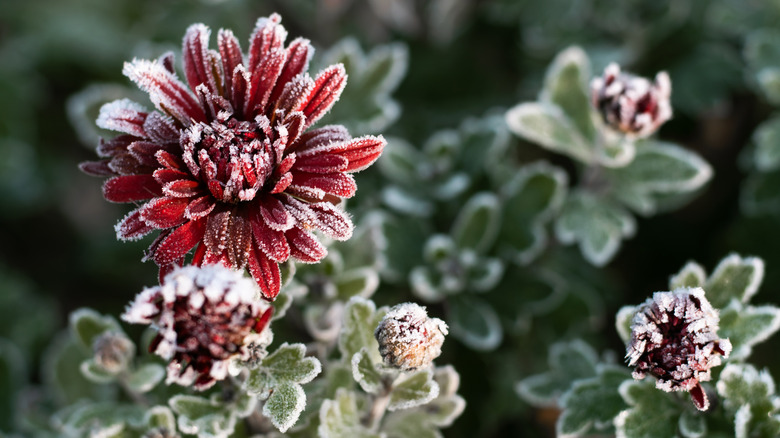Here's How To Grow Mums In Containers And Keep Them Thriving Throughout The Fall
Chrysanthemums, also called mums, are one of the most popular flowers to add a splash of color once your seasonal summer flowers have faded. They come in a range of colors — yellow, purple, orange, red, pink, white, and even bicolor options — and are relatively easy to care for. All they need is plenty of sunlight while they're blooming and wet, nutrient-rich soil to thrive, per Garden Design. Cultivating these blooms in a pot instead of directly in the ground allows you to maintain these conditions for the plant, with the added flexibility to style your front porch throughout the season.
What many people don't know, however, is that mums can be maintained as perennials, not just as an annual pop of color in the fall. If you can't seem to part with your autumnal blooms, keep reading to learn how to maintain your potted chrysanthemums throughout the winter frost instead of replanting each year.
Choose a high-quality plant
The first step in ensuring your mums survive the winter is choosing the correct variety. According to Costa Farms, this popular flower has two main types. Florist mums are grown as annual flowers, and they're not meant to withstand the cold winter weather and are sold just about everywhere, from the grocery store to garden centers. For a temporary pop of color for a few weeks during fall, they do a great job, but they likely won't last very long once the temperatures begin to drop.
Garden mums, also referred to as hardy mums, are the stronger variety of the two and are typically cultivated as perennials. They're meant to last year after year, and with proper care and pruning, they'll make it through the winter frost. When shopping, look out for the labels on the side of the pot and choose the type of mum that works best for what you're looking for.
Look out for defects
Whether you choose a florist or garden mum, it's a good idea to inspect the plant for over or under-watering and any broken or droopy branches to ensure that you get the longest life and prettiest blooms out of your purchase. Plants are often cramped together during transport, resulting in damages and squished buds, and cheaper options may not be adequately maintained before they're sold, via Costa Farms. Broken stems won't bloom and could leave you with unsightly bald spots in your flowers.
If the plant you pick up looks a little sad and dehydrated, it'll perk up after watering, but the blooms might not last as long as a healthy plant. If the plants were overwatered consistently, you might have the same issue. A plant may look more beneficial after a bit of TLC, but the flowers won't bloom as brilliantly as they would if it was healthy its whole life.
Repot once you bring your plants home
By the time you bring your plants home, they've been living in a cramped pot for quite a while. If you want them to last, give the roots some space to breathe in a larger pot. This will ensure they can absorb the nutrients and water necessary to thrive, even during colder months.
According to Adams Fairacre Farms, to properly repot your mums, you should prepare a new pot larger than the one they came in and add a layer of potting mix at the bottom a few inches deep. From there, flip the old pot upside down, support the plant at its base, and tap to loosen the roots. Once it comes out of the pot, gently shake or massage the root ball to break it up. Put the plant into the new pot and fill with more potting soil until there's about an inch of free space at the top. Lightly water, and voilà, you've safely repotted your chrysanthemum.
Give your plants enough water and sun
Mums are pretty simple to care for. Once you've planted them, ensure they get a lot of indirect sunlight. They'll thrive on 6 to 8 hours a day, but super sunny conditions can cause them to wilt and dehydrate, via Costa Farms.
When it comes to the frequency of watering, it all depends on your weather conditions. According to Farmer's Almanac, chrysanthemums need proper drainage to ensure they're not faced with root rot, but they do well with daily watering in most climates. If it's sunny and still warm where you live, check the soil and water more often and moisturize if the top layer is dry. If it's rainier, scale it back and only water when necessary. When it comes time to water, make sure you're only getting the soil wet, not the blooms and leaves. This can help the plant absorb the water deep into the root system instead of just sitting on top of the soil.
How to overwinter mums
Hardy chrysanthemums can survive a bit of frost, but if you want them to make it through winter, there are a few steps you can take to ensure they won't die during the consistently cold weather. According to Organically Green, the easiest way to overwinter your mums is by bringing them inside. Trim off any brown branches and then take the pot into a garage or shed, wrapping them with a sheet or towel. Make sure you're still watering them throughout the season, and then bring them back out once the weather warms a bit in spring. If you live somewhere warmer, you can also keep them outside; just consider adding a layer of mulch to help insulate the plant and keep an eye out for extended freezes.
Mums are well-known as fall plants, but they don't have to be only seasonal decorations. With a bit of extra care, you can cultivate your mums as perennials and keep their brilliant burst of color year-round.
